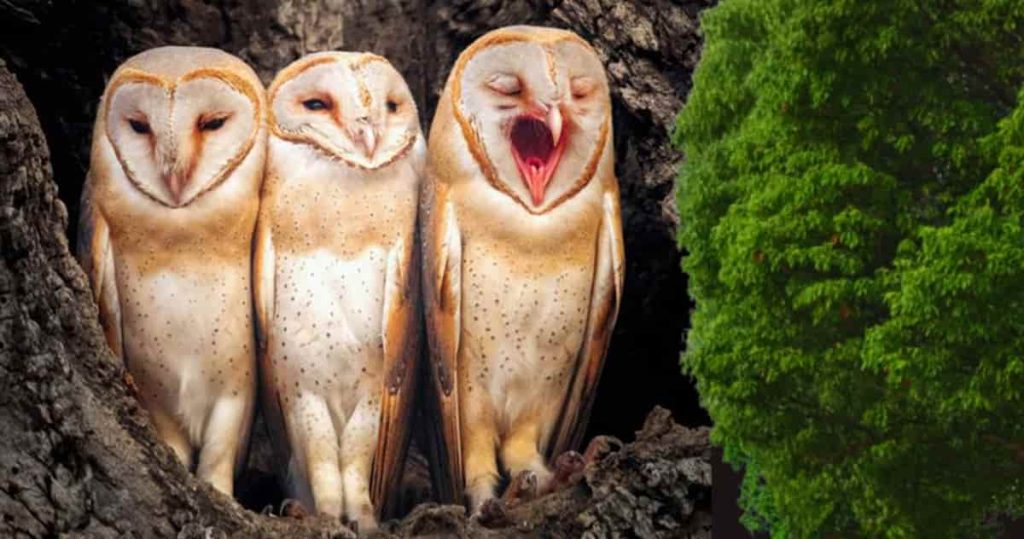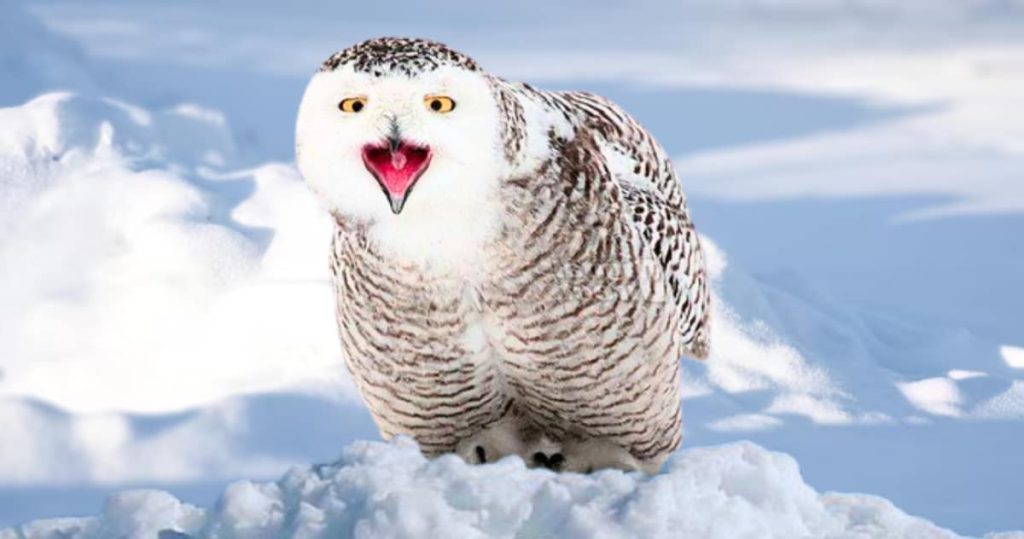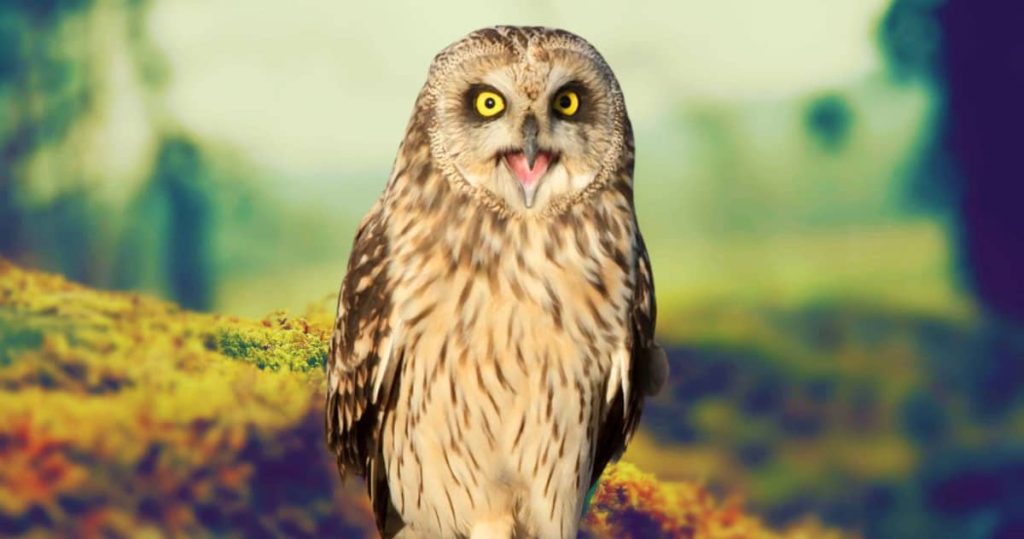
Like other parts of the body, the owl tongue has an important role, so the answer to the question, Do owls have tongues? is yes.
Swallowing food is very difficult for owls without a tongue. The saliva on the owl’s tongue lubricates the food, which makes it easier for them to swallow food.
Also, to prepare the food in the mouth for swallowing and to expel unnecessary waste of food through their mouth, they use the tongue.
The undigested waste of prey ingested by owls with their diet are Owl pellets which they throw through their mouths. The function of an owl’s tongue is to expel these pellets out of the owl’s mouth.
Contents
- 1 Do owls taste their food?
- 2 Does the owl’s tongue help with their hooting?
- 3 Feature of Owl Tongues
- 4 1. Structure
- 5 2. Hidden Tongue
- 6 3. Limited Taste Sensation
- 7 4. Size Variation
- 8 5. Papillae
- 9 6. Specialized Feeding Strategy
- 10 What is the hole in the owl’s tongue?
- 11 Do owls have uvulas?
- 12 How long are owl tongues?
- 13 Why do owls open their mouths?
- 14 What is the function of the tongue in a bird?
- 15 Which bird has the longest tongue?
- 16 Barn owl tongue
- 17 Great horned owl tongue
- 18 Snowy owl tongue
- 19 Screech owl tongue
- 20 FAQs
- 21 Conclusion
Do owls taste their food?

Since owls swallow their food whole, many of us may wonder, do owls taste their food? Like us, owls also have taste buds on their tongues, but the number of taste buds in owls is comparatively less than ours.
Owls have very limited taste buds on their tongues such as bitter, salty, and sour. Just as smell and taste play a major role when we eat food, owls, on the other hand, have no sense of smell, so they select and eat their prey mainly due to their adaptations.
The movement of a prey makes the owl more attracted to its food. Their unique eyesight and keen sense of hearing make them more prone to hunting.
Does the owl’s tongue help with their hooting?
The human larynx is known as the voice box or glottis. Although humans have a larynx, they cannot make any sound with their voice box or lips without their tongue. Many of us may be wondering if owls can hoot without their tongues.
Owls have a larynx known as a syrinx. Owls do not make any sound, but they have vocal cords, which they make with their syrinx, trachea, and lips.
The function of owls hooting in defending their territory and attracting mates is very important. Owls do not need a tongue to hoot, so they can hoot without the help of their tongue.
Feature of Owl Tongues

All animals on Earth have different tongues. Although some of the functions of animals’ tongues are similar, their tongues have some unique functions. Some features of the owl tongue are mentioned below.
1. Structure
The shape of the tongue of owls varies between species as the barn owl’s tongue is long and narrow, the eagle owl’s tongue is broad and has strong papillae, scops owl’s tongue is narrow and long which eats small insects from tree crevices.
Owls have triangular tongues with taste buds and papillae. They have more taste buds and papillae on the back of the tongue than on the front. The structure of the papillae varies depending on the diet of the owl species. The papillae are round and elongated which helps in the retention of food.
In addition, the salivary juice released from the salivary glands creates a slippery or oily coating on the tongue. Since owls do not tear apart their prey like other birds of prey, instead they swallow the prey whole, salivary glands play an important role in gliding the prey.
2. Hidden Tongue
The tongues of hummingbirds and woodpeckers can be seen when they feed, but the tongues of owls like them are not easily seen. Owls are sometimes seen yawning when they feel tired, and just as we yawn, the only time we see owls’ tongues. That is why the tongue of owls is included in the list of hidden tongues.
3. Limited Taste Sensation
Just like human tongues have taste buds, owls also have taste buds, but they are much smaller in number than ours. Owls have more taste buds at the back of their tongues than at the front. They usually perceive bitter, salty, and sweet tastes somewhat, but less than us. Owls swallow their prey, so they don’t need as much of a sense of taste as we do.
4. Size Variation

Owls have an average tongue size of 2–2.5 cm (0.8–1 inch) long. However, we see many species of owls living in the world, so the size of their tongues can vary. Smaller species of owls have smaller tongues, and larger species of owls have larger tongues. In addition, depending on the species, you can see the colors on the owl’s tongue.
5. Papillae
Although all animals do not have papillae on their tongues, owls have a variety of papillae on their tongues. These papillae can be round or elongated. Sometimes taste buds are also found on papillae. Papillae are mixed with saliva when they hold prey on the tongue, helping to swallow.
6. Specialized Feeding Strategy
Owls’ favorite diet includes small vertebrates and small insects. They swallow their whole prey. Like a snake, the owl’s tongue has an important function in swallowing the prey whole. The papillae on the tongue help the owl’s tongue stick firmly to its prey. Owls mix the prey with saliva and swallow it through their tongues.
What is the hole in the owl’s tongue?

There is no hole in the owl’s tongue, but the hole-shaped part at the very end of the owl’s tongue is called the glottis, which is the entrance to the windpipe.
The glottis of owls are not easy to see, only visible when owls yawn. This glottis acts as a valve when owls eat prey. The glottis prevents food from entering the lungs.
The sound of hooting that owls make is created in this glottis. When owls hoot, this glottis opens and closes rapidly to force air out of the lungs, causing a sound known as the owl hoot.
Owls use this hoot during the breeding season to attract mates, to warn off predators, to defend their territory (to warn other owls).
Do owls have uvulas?

The uvula is a thin hanging lump of flesh at the back of the mouth and the beginning of the throat that is present in many mammals, including humans, but not in birds, including owls.
The uvula doesn’t have many functions in our body but it can have some problems in making some of the sounds we make like ah, oh.
There is no problem, If someone is born without a uvula. Even if someone’s uvula is surgically removed for some reason, there is also no problem.
The human vocalization process and the owl vocalization process are different, and the uvula is not very useful for the owl’s body because they swallow their prey. Having a uvula would have made it difficult for owls to swallow food and throw out pellets with their mouths.
How long are owl tongues?

Their tongues vary in length among the roughly 254 species of owls on Earth. Although the function of the tongue of all species of owls is the same the tongue length of large owls is longer than that of small owls. Owls have an average tongue length of 1-3 cm.
Below are the names of some owl species along with their tongue length:
| Sl. No. | Type of owl | Length |
| 1 | Barn owl | 2 cm (0.8 inch) |
| 2 | Great Horned Owl | 2.5-3 cm (1-1.2 inches) |
| 3 | Snowy Owl | 2-2.5 cm (0.8-1 inch) |
| 4 | Eastern Screech Owl | 2-2.5 cm (0.8-1 inch) |
| 5 | Tawny owl | 2.5 cm (1 inch) |
| 6 | Barred owl | 2.5-3 cm (1 to 1.2 inches) |
| 7 | Burrowing owl | 1-2 cm (0.4-0.8 inches) |
| 8 | Southern Boobook | 1-2 cm (0.4-0.8 inches) |
Why do owls open their mouths?
We often see owls open their mouths. owls open their mouths for many reasons. Just as we sometimes open our mouths to yawn when we are tired, owls also yawn to relieve fatigue.
They open their mouths when they are hooting. The prey has to open its mouth for food. All birds have fewer sweat glands, so owls cool their bodies by evaporating their saliva, especially in hot weather when they fly and sit, opening their mouths to cool their bodies.
Owls clean their feathers from time to time by opening their mouths to clean the feathers with their beaks.
What is the function of the tongue in a bird?
Their tongues are used for different purposes by various species of birds, including owls. Hummingbirds and nectarivores use their slender tongues to extract nectar from flowers.
Waterfowl, such as ducks and geese, use their tongues to filter plankton and small fish from the water.
Woodpeckers collect insects from tree bark with their long tongues.
Birds such as hawks, eagles, vultures, and owls use their tongues to evaporate to cool their bodies.
Parrots, cockatoos, mynas, etc. are birds that can imitate human language, so they use their tongue to speak.
Besides, birds have their tongues to clean feathers and sense taste.
Which bird has the longest tongue?
The giant anteater takes the first position in the list of animals with long tongues worldwide. Their tongues can be up to 2 feet long, which serves to collect termites and ant eggs.
A bird’s tongue has evolved according to its purpose. The northern flicker, a woodpecker with the largest tongue, can protrude its tongue up to 10 centimeters (4 in) at the tip of its beak.
Hummingbird tongues are also enlarged to collect nectar from deep within flowers. Their tongues can be up to twice the size of their lips. The average length of their tongue can be about 4 centimeters (1.6 inches).
Barn owl tongue
Because the barn owl is a medium-sized owl, its tongue is also medium-sized, averaging about 2 centimeters (0.8 in) in length. This species of owl is noted for its beautiful facial structure.
Barn owls are specified as common owls around the world, which is why albino barn owls are largely seen in the world, followed by albino screech owls.
Barn owls use their tongues to hold prey, easily swallow prey, and clean their feathers. But barn owls don’t use their tongues to call like we do.
Great horned owl tongue
A common owl species in America is the great-horned owl, which is a large species of owl. The great-horned owl is big, and their tongue size is also big, which is about 2.5–3 cm (1–1.2 inches).
Their tongues have papillae of various shapes like other species of owls, that help them swallow and hold their prey.
A wet owl’s feathers leave them susceptible to infection by a variety of fungi. Owls shake their wet bodies and remove excess water and dirt from their bodies with their tongues.
Snowy owl tongue
The snowy owl is categorized as a common species of white owl in arctic regions. The only white owl species in the world, also known as the migratory owl species, The tongue of this large owl is 2–2.5 cm (0.8–1 inch).
Like other species of owls, their tongues have very few taste buds, so they have very little sense of taste. It can be said that their tongue has no role during hooting. Their tongue serves them to hold prey, swallow prey, and throw pellets into their mouths.
It should be noted here that many of us mistake owl pellets for owl poop. Besides, to clean their feathers, snowy owls also use their tongues.
Screech owl tongue
Several subspecies of this small species of ow are found, most commonly in eastern North America. The average tongue length of this species of owl is 2–2.5 cm (0.8–1 inch).
And like other species of owls, they mainly use their tongues to catch and swallow prey. The tongue has very few taste buds, and its papillae are of different shapes to create friction.
They can do hooting without a tongue. hooting, which serves to secure their territory and attract mates during the breeding season. An owl’s tongue has an important function in caring for its feathers.
FAQs
Q. Does an owl have a tongue?
Ans: Every owl has a tongue with taste buds and papillae.
Q. How to owl hoot with your mouth?
Ans: Owls use their larynx for hooting, known as the syrinx, which has a major role, but owls do hoot by rapidly expanding from the lungs through the trachea.
Q. What does an owls mouth look like?
Ans: Owls’ faces are larger than their bodies. Owls’ mouths are developed for swallowing prey, so they can open their mouths wide. While other birds’ eyes appear on the sides of their heads, most species of owls have their eyes forward like ours.
Q. How strong is an owl bite force?
Ans: We know that predatory animals like tigers and lions have very powerful bites, but owls, even though they are birds of prey, do not have powerful bites. The average pressure of an owl’s bite is only 30–120 psi.
Q. Do owls have taste buds?
Ans: Yes, owls have taste buds like us, but their number of taste buds is much less than ours.
Conclusion
Above, I’ve covered all the facts about owl tongues in response to the question, Do owls have tongues? An animal’s tongue has a vital role in their intake of food.
Our tongue is especially needed for talking and eating. We cannot speak at all without our tongue.
I have supplied all important information related to owls on my website. You can visit my website again if you need it and share it with friends if needed.
The more we learn about the owl, the more we can help preserve this beautiful animal from extinction.